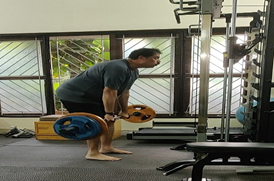
Mr Rajan Balakrishnan, who is one of the Physiotherapy Lecturers in the Faculty of Health Sciences (FOHS) MAHSA University, has authored a research paper on "Influence of powerlifting on cardiovascular responses in obese individuals" which was recently published in the International Journal of Physical Education, Sports and Health, Volume 10, Issue 2, 96-99, P-ISSN 2394-1693
Picture: 1.Healthy Powerlifter
Powerlifting has three disciplines which are, squat, bench press, and dead lifting. There may be very heavy weights lifted during training and competitions. In the competitions the powerlifter has to lift with each technique 3 times and the highest weight is recorded. It is calculated as four times more than own body weight. During training, muscle strength increased by submaximal loads, and in a previous study, powerlifters exercised, on average, 6.1 ± 2.4 h/week. During the powerlifting techniques the cardiac output gets increased and it increases heart rate within the magnitude of the increase dependent upon the intensity of the exercises. During physical exertion there is an increase in cardiac output, a rise in systolic blood pressure is a natural consequence of dynamic exercises. Diastolic blood pressure remains unchanged or shows only a slight increase as a consequence of metabolic vasodilatation of the peripheral vessels.
The objective of the study was to determine the Heart Rate variation in obese person - pre and post powerlifting exercises which included determining the systolic blood pressure changes in obese person - pre and post powerlifting exercises; determining the diastolic blood pressure variation in obese person - pre and post powerlifting exercises.

Picture: 2: Obese Powerlifters
The results have identified that there were significant differences shown within the exercises and between the exercises. Anova analysis of the p-value corresponding to the F-statistic of one-way ANOVA is lower than 0.05, suggesting that the one or more exercises are significantly different. On analysing with the post hoc test. The results of this study show both exercises were improved whereas there was a significant improvement noted on Pre-test, immediate post and 1 week after post. So, this study rejects null hypothesis.
This study concludes that there is a significant rise in the heart rate and blood pressure following exercises, but the elevation of these cardiac parameters will tend to reduce following regular exercises.
